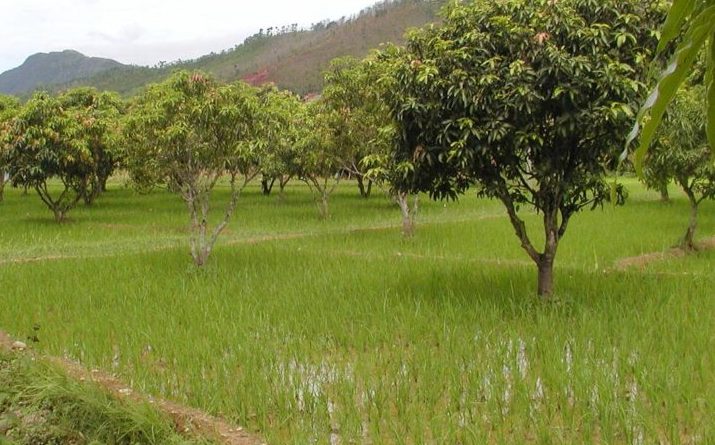Agroforestry in Carbon Sequestration and India’s National Agroforestry Policy
Photo by Sajal Sthapit / CC-BY-NC-SA
Article by Elenor Bates
Agroforestry, the practice of incorporating food crops into native forestry systems is increasingly being viewed as a useful tool for carbon sequestration.
Agroforestry systems can be used as a method of carbon sequestration because they store carbon in the soils and biomass as well as reduce greenhouse gas emissions from the soils (2). Agroforestry has the potential to be a major player in removing CO2 from the atmosphere because 630 million hectares’ area is available for agroforestry, which could sequester 586 Mt C per year by 2040 (5). Carbon sequestration can occur through agroforestry in two different ways – expanding existing carbon sinks and substituting biomass as an energy source instead of fossil fuels or wood – depending on the type of agroforestry system (2). The inclusion of trees on agricultural land contributes to the carbon sinks through photosynthesis and leads to an enhancement of carbon storage in tree components for long term storage (5). Studies on carbon sequestration in soils around the world revealed a general trend of increasing soil carbon sequestration in agroforestry as compared to other land-use practices, suggesting that agroforestry practices increase the amount of carbon stored in the soil (2).
Carbon in above-ground and below-ground biomass is generally much higher in agroforestry systems than croplands without trees (4). In perennial agroforestry systems, the trees are allowed to grow full time, which stores more carbon in the wood biomass (5). In substituting this biomass as a fuel alternative, this would decrease the need for fossil fuels as energy sources as well as conserve forests through decreased demand for fuel-wood originating in natural forests.
National Agroforestry Policy (India)
In 2014, the Agriculture and Cooperation Department of the Government of India (GoI) created the National Agroforestry Policy. The policy outlines the benefits of agroforestry, why it is needed in India, the goals and objectives of the policy, the strategy for implementing the policy, and the pathway to achieve the goals of the policy. The National Agroforestry Policy is the first of its kind and is considered to be “a path-breaker in making agroforestry an instrument for transforming the lives of the rural farming population, protecting ecosystem and ensuring food security through sustainable means” (1). The goals of the policy are not solely environmental; the goals also include “improving the productivity; employment, income and livelihood opportunities of rural households” and “meeting the ever increasing demand of timber, food, fuel, fodder, fertilizer, fiber, and other agroforestry products” (3). Therefore, this policy demonstrates to other nations how the GoI believes agroforestry can provide many benefits, whether they are social, economic, or environmental.
The National Agroforestry Policy includes six basic objectives:
- promote agroforestry to improve productivity, employment, income, and livelihood
- protect ecosystems and encourage resiliency to minimize the threat posed by extreme climate events
- increase production of and reduce import of wood
- reduce pressure on natural forests by using agroforestry products
- increase forest and tree cover
- develop research in agroforestry (3)
The key strategies that they plan on using to achieve these goals include:
- creating a national institutional set-up to implement the policy
- simplifying regulations on harvest and transport with trees used in agroforestry
- developing a database of land records to promote land tenure security
- developing an information system to record agroforestry data
- investing in research
- providing access to planting material
- providing insurance cover for agroforestry practices
- promoting industries working with agroforestry and biomass
- promoting sustainable agroforestry for biomass energy (1, 3)
The National Agroforestry Policy demonstrates a movement towards agroforestry becoming a common agricultural practice. Apart from environmental benefits, this policy has promoted the social and economic well-being of family farmers.
References
- Chavan SB, Keerthika A, Dhyani SK, Handa AK, Newaj R, Rajarajan K. 2015. National agroforestry policy in india: A low hanging fruit. Current Science (00113891) [Internet]. [cited 2016 Nov 3]; 108(10):1826-34.
- Dhyani SK, Ram A, Dev I. 2016. Potential of agroforestry systems in carbon sequestration in india. Indian J Agric Sci [Internet]. [cited 2016 Oct 22]; 86(9):1103-12. Available from: https://www.researchgate.net/profile/Asha_Sirvi/publication/308119598_Potential_of_agroforestry_systems_in_carbon_sequestration_in_India/links/57daaf8708ae5292a3767ea3. pdf
- [GoI] Government of India (IN). 2014. National agroforestry policy [Internet]. New Delhi (IN): Ministry of Agriculture; [cited 2016 Nov 3]. Available from http://www.indiaenvironmentportal.org.in/files/file/Agroforestry%20policy%202014.pdf
- Murthy IK, Gupta M, Tomar S, Munsi M, Tiwari R, Hegde GT, Ravindranath NH. 2013. Carbon sequestration potential of agroforestry systems in india. Journal of Earth Science & Climatic Change [Internet]. [cited 2016 Oct 22]; 4(1):1. Available from:
http://search.proquest.com/docview/1419370147?accountid=10422
- Sharma R, Chauhan SK, Tripathi AM. 2016. Carbon sequestration potential in agroforestry system in india: An analysis for carbon project. Agrofor Syst [Internet]. [cited 2016 Oct 22]; 90(4):631-44. doi: 10.1007/s10457-015-9840-8

